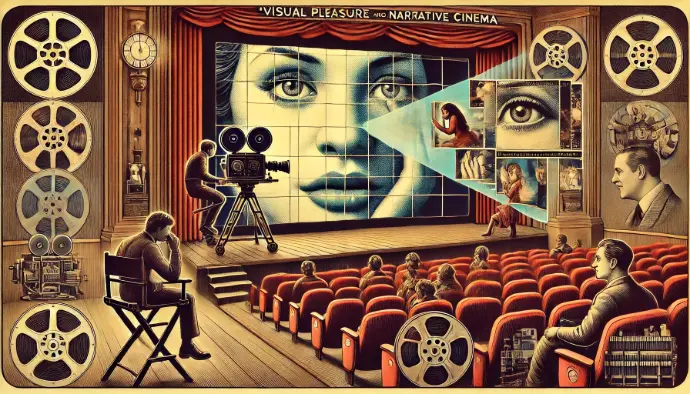Visual Pleasure and Narrative Cinema
Laura Mulvey's seminal 1975 essay, "Visual Pleasure and Narrative Cinema," critiques classical Hollywood cinema's reinforcement of patriarchal ideology, arguing that mainstream films are structured around male pleasure, objectifying women as passive subjects for the male gaze.

Visual Pleasure and Narrative Cinema
Introduction
Laura Mulvey’s groundbreaking 1975 essay, Visual Pleasure and Narrative Cinema, revolutionized film theory by introducing feminist psychoanalysis to cinema studies. Mulvey, a British film theorist and professor, critiques classical Hollywood cinema for its reinforcement of patriarchal ideology, arguing that mainstream films are structured around male pleasure, objectifying women as passive subjects for the male gaze. Her work, influenced by Freudian psychoanalysis and Jacques Lacan’s theories of identity formation, explores how visual pleasure operates in narrative cinema through scopophilia (pleasure in looking), voyeurism (pleasure in observing without being seen), and identification (aligning with a character’s perspective).
The Male Gaze
A central concept in Mulvey’s theory is the "male gaze," where cinematic representation privileges a heterosexual male perspective. She argues that in classical Hollywood cinema (1920s–1960s), women are positioned as passive spectacles to be looked at, while men drive the narrative as active agents. This dynamic reflects broader societal structures in which women are seen as objects of desire rather than subjects with agency. The male gaze manifests in three ways: the perspective of the male character within the film, the camera’s framing of women, and the spectator’s alignment with the male viewpoint. A prime example is Alfred Hitchcock’s Rear Window (1954), where Jeff (James Stewart) watches Lisa (Grace Kelly) as an object of desire, reinforcing voyeuristic pleasure.
Scopophilia and Voyeurism
Mulvey draws on Freud’s concept of "scopophilia"—the pleasure derived from looking—to analyze how cinema constructs visual pleasure. In narrative cinema, this pleasure is often tied to voyeurism, where the audience derives satisfaction from observing the female form without her knowledge. Classic Hollywood films frequently employ techniques that encourage this voyeuristic pleasure, such as the fragmentation of the female body through close-ups and slow-motion shots, emphasizing physical allure over individual subjectivity. Marilyn Monroe’s iconic subway grate scene in The Seven Year Itch (1955) is a textbook example, where her body is framed to maximize visual pleasure for the male spectator.
Identification and the Mirror Stage
Mulvey incorporates Lacan’s theory of the "mirror stage," where individuals form their identity by identifying with idealized images. In cinema, male viewers identify with the male protagonist, whose perspective dominates the film’s visual language. This identification process reinforces traditional gender roles, as men see themselves as active participants in the narrative, while women are relegated to passive positions. Female spectators, Mulvey argues, must either adopt a masochistic position by identifying with the objectified female character or take on the male perspective, aligning with the active subject. In Vertigo (1958), Scottie (James Stewart) obsessively remakes Judy into his idealized vision of Madeleine, illustrating how male subjectivity controls the female image.
The Female Spectator and Alternative Cinema
While Mulvey primarily critiques classical Hollywood cinema, she also acknowledges the potential for alternative cinematic practices that challenge the male gaze. Experimental and feminist films, such as those by Chantal Akerman (Jeanne Dielman, 23 quai du Commerce, 1080 Bruxelles, 1975) and Agnès Varda (Cléo from 5 to 7, 1962), disrupt conventional narrative structures and visual pleasure by refusing to objectify women or by presenting female subjectivity in complex ways. These films resist scopophilic pleasure and encourage spectators to engage with the film on a critical level rather than passively consuming the imagery. Akerman’s Jeanne Dielman (1975), with its long, static shots of domestic labor, deconstructs traditional cinematic pleasure by focusing on a woman’s routine rather than her desirability.
Criticism and Reinterpretation
Although Visual Pleasure and Narrative Cinema remains a foundational text in film theory, it has faced criticism for its rigid application of psychoanalytic theory and its focus on heterosexual male spectatorship. Scholars such as bell hooks have challenged Mulvey’s work for neglecting race and intersectionality, arguing that Black female spectatorship requires different analytical frameworks. Additionally, some critics have pointed out that not all women in cinema are portrayed as passive objects; characters in films by directors like Stanley Kubrick (The Shining, 1980) or Ridley Scott (Alien, 1979) exhibit complex agency and resistance. Moreover, contemporary theorists like Judith Butler have expanded the conversation to include queer spectatorship, questioning the binary gender roles assumed in Mulvey’s argument.
Impact on Film Studies and Popular Culture
Mulvey’s essay has had a lasting impact on film studies, influencing feminist film criticism and inspiring scholars to explore the role of gender, power, and spectatorship in cinema. The concept of the male gaze has been applied beyond classical Hollywood, shaping discussions about media representation in television, advertising, and digital culture. Contemporary filmmakers have responded to Mulvey’s critique by creating more nuanced and self-aware portrayals of women. Greta Gerwig’s Barbie (2023) directly engages with the male gaze by deconstructing gendered expectations, while Céline Sciamma’s Portrait of a Lady on Fire (2019) presents a female gaze, emphasizing mutual looking and subjectivity rather than objectification.
Conclusion
Visual Pleasure and Narrative Cinema remains a seminal text that continues to provoke discussion and reinterpretation. While Mulvey’s arguments primarily address classical Hollywood cinema, her insights into the mechanisms of visual pleasure and gendered spectatorship remain relevant in contemporary media analysis. By critiquing the male gaze and advocating for alternative cinematic approaches, her work has helped reshape how audiences, scholars, and filmmakers engage with visual storytelling. With the rise of streaming platforms and digital media, discussions on visual pleasure continue to evolve, examining how new technologies impact the politics of representation and spectatorship.